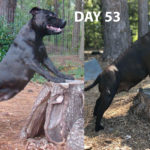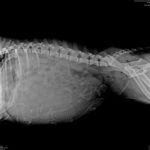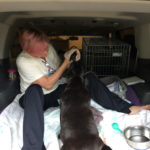There are times I question why I decided to breed dogs.
This week is one of those times. If you follow this blog then you already know about our last litter – it was bittersweet, exhausting, expensive, educational and fulfilling all at once. Multiply those emotions and facts for this past few days and you will understand my feelings a little better. I have included some interesting (to me) photos above from this litter experience. If you think all breeders are alike then you must not follow this blog or you live under a rock. What I show/do/describe/experience doesn’t make me better/worse than other breeders. I write about what I experience mostly for my own sanity, but also in the hopes that readers can learn a little bit – about breeding, about Staffords and about me. I also hope it educates them on the ‘ART OF PUPPY BUYING’ and everything that can, and should be a part of it.
Above you will see how we take photos of each bitch and he progression in her pregnancy and we can compare her to generations before her. We keep detailed notes from the moment she is born, on each season, each mating and throughout her pregnancy, whelping experience and raising the puppies. It doesn’t stop there but this blog today is mostly about this particular breeding experience.
We knew the semen we used was of good quality and we knew the bitch was healthy and young. The veterinary clinic we use is one of the best reproductive clinics in the country with two board certified Theriogenologists on staff. We did all health testing, timing, driving, sparing no expense – we did a surgical AI using frozen semen shipped to us from Italy. It was of very good quality upon thaw. The bitch conceived and progressed as expected without incident. We fed an appropriate diet, supplemented as directed and kept her in shape, not over feeding. Check ups went well, ultrasound showed 6-7 fetuses, all normal. We knew she had resorbed some at the x-ray and saw 4 good sized normal looking lined up puppies waiting to be born days later. Stage one began as expected and progressed normally. I move into the whelping room with each bitch approximately two weeks prior to due dates. I like to get them accustomed to the room. We use a guest room so she can be away from the other dogs in the home, in a dark quiet space but not too far from my husband in our room. The night before her due date (based upon progesterone, LH, ovulation) I slept on the floor beside the whelping box carefully monitoring her as she progressed. I take notes and photos along her journey as well as using Young Living oils to diffuse and massage.
I wont post the actual whelping photos here because for me thats personal for my experience and comparisons for each whelping. I will tell you that with each litter I gain experience and education that I never knew I lacked. In past blogs about the last litter you read we learned to tube feed, give oxygen and FFP and sub q newborns. With this litter I learned about stuck puppies (how to get them delivered and also how sometimes you just can’t), new (to me) resuscitation methods (including but not limited to accordion method, DeeLee catheters and CPR).
I also learned that sometimes the vet you choose to join you on this journey can be so invaluable! I always loved and trusted Dr Ana and she has made puppies from nothing for us – she is fantastic and words cannot describe how much respect I have for her. This time we worked with her colleague Dr. Bob and wow did we connect! He is another veterinarian whom I hold in admiration and have a tremendous amount of respect for as well. I consider myself quite lucky to have developed a good working relationship with both of these talented and kind doctors. I also learned that my local emergency clinic can be amazing! We have used them in the past with mixed results but there is one Dr there we have worked with a few times now who was a HUGE part of this delivery, Dr Houghton. Our fourth and final puppy was stuck and our bitch was suffering dystocia. I knew something wasn’t right with the puppy and that I would not be able to free her. Dr. Houghton was kind, understanding and helped me through the tears of losing the one bitch in this litter as she removed her from the birth canal. The puppy was stillborn. She understood how we did not get a bitch last litter, lost one of the two puppies last time and had three boys this time, the first one being stuck himself. She spoke with Dr. Bob (who was on a day off I need to add and who answered his phone at 5am anyway) and together we made sure our bitch was safe and would be ok. She was our main priority.
We took everyone in the next day and Dr. Bob assessed all was well – we did sub Q for everyone and added Arnica 6c and more probiotic. With another 12 hours of constant monitoring and care today on day 3 we are doing well. The three handsome boys are gaining weight, Bay is being an amazing mama ad finally getting the sleep she desperately needs. I am still in the whelping room (as I type I can hear her snores in the box next to the bed) and I will remain here for the next two weeks.
Our wait list consisted of extremely patient people who have been waiting through three litters now and two families who already purchased puppies from us. All wanted girls.
Why did I decide to become a breeder? If you could hear the snores and squeaks I am listening to right now you would totally understand.


















































